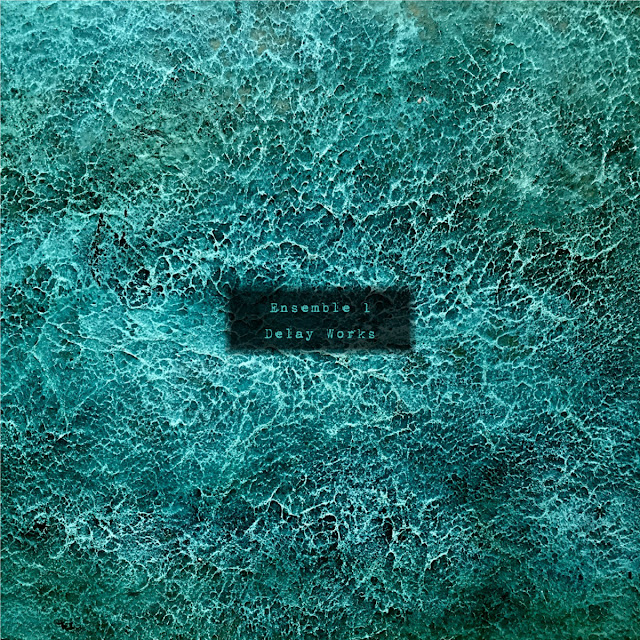KLAVIER KRIEGER - .:. SCONSACRATI INFANTI DI CIELO .:.
The atmospheric black metal
associations suggested by neologisms like ‘hellnoise’ and concepts like
embracing the void in this album’s Sufi manifesto-like liner notes are not
without relevance; but they’re more a part of the tapestry than the dominant
motif. “The dark vibe to Klavier Krieger is an accident,” explains the artist
behind the avatar (who wishes to remain anonymous for professional reasons) in
an email exchange. “It just comes out dark because I’m carrying a
lot of heavy shit that I keep a lid on. I’ve had friends give me skulls, robes,
a human kidney, a monkey skull, weird shit like that as gifts, so it figures I’d
find some use for it.”
If there’s a spiritual ancestor
for this release (available as download or cassette through the Bandcamp page linked below) it would be avant-metal guitarist Rev. Kriss Hades’ 2005 live
album Paganini - Bloodlust - Static Age.
Both are works by underground Melbourne musicians who aim to establish an
original style by blending various formal shades of contemporary classical and
metal subgenres. Hades’ prankster experimental take on symphonic black metal
extends to backmasking audience noise rather than music. There's a similar humour
and playfulness in the creative approach of this ivory monarch, but neither
artist could be accused of lacking a serious design.
This is a 34-minute recording,
divided roughly into two 17-minute parts (entitled ‘BVIO’ and ‘LVCE’), of a
performance at the Bendigo Hotel in Collingwood. KK uses a digital piano put
through a guitar multi-effects unit for extra grunt, two synthesizers, and two
separate looping stations for vinyl record player and vocals. The resulting music
certainly has some of the ritualistic flavour purveyed by blackened ambient
entities like Abruptum, Gnaw Their Tongues, Stalaggh, Burial Hex and Nekrasov. Coil’s
Musick to Play in the Dark series is also a relevant reference point for
Klavier Krieger’s more subtle blending of Gnostic mystery and eerie sonority. The
music demands (and certainly deserves) to be heard with the same level of clarity
and spatial separation as those groups’ best studio work allows. However, there’s
something to be said for hearing KK in a live setting to get a grip on practice
divorced from artificial psychoacoustic enhancement. It’s hard to get the full Burzum-esque
dungeon synth vibe that some elements of presentation would suggest (monk robes
a la Sunn O))) for instance) when punters are still exchanging pleasantries over
initial ceremonial bell strokes and the introduction of ultra-high/low
frequency sine tones.
Sconsacrati Infanti Di Cielo
roughly translates as “Deconsecrating the Infants of Heaven”. A dyslexic misreading of “seraphic” as “Sephardic” in
the liner notes can set the inquisitive listener searching for Jewish mystical connections
in contemporary experimental music. Charlemagne Palestine and Ghédalia Tazartès
presented front of cortex, and neither are completely off the mark. There are digital
church organ chords sustained in a Palestinian manner. Upper register piano arabesques
become more laminar with echo, eventually creating a strummed resonance (though
equally comparable to Anthony Pateras’ hard minimalist explorations of timbre like
Blood Stretched Out). Samples of primary school-age child voices and baby cries
intersecting with hallucinatory muezzin wails conjure a Tazartean pantheistic blend.
Klavier Krieger music isn’t full-on cri de void as much as he seems to proclaim
it as such (“no identity as the only constant .:. only .:. being to embrace the void”
concludes the liner poem). It’s more an embrace of ego dissolution through synaesthesia, an eternal quest for enhanced experiential holism through sound.
KK mentions the piano etudes of Einojuhani
Rautavaara as a key influence. Symphony No. 6 "Vincentiana"
(1992) for orchestra and synthesizer from Rautavaara's opera Vincent
(1987), is where the Finnish composer’s Neo-Romantic qualities come closest to
the dissonant textures that KK music also delivers. The synth's alien
interjections in that piece have an almost comical disposition placed alongside
the orchestra's vertical harmony and tonality. On SIDC, the two differentiated
methodologies are pushed towards a more symbolic union with varying levels of
success. No recognisable themes as such (other than those sampled), but there’s
certainly gestures aimed at fusing the tonal and the atonal, the chromatic and
monochromatic.
It starts in a manner redolent of
Black Mountain Transmitter with higher pitched auras efflorescing around a
succession of queasily deep synth tones. Beast growls open up as synth-ish
oscillations a la Stockhausen’s proto-Spectralist vocal work Stimmung
into monkish intonations that ascend in a transcendent direction. Over a sustained church organ patch, they become ecstatic whines that bring to mind Stalaggh's
howling choirs, but leavened with Burial Chamber Trio's solar drones. Even if
you think Projekt Misanthropia's mind flaying reputation is a little
overblown, and its whole backstory an elaborate hoax, it would still impress
for the sheer brio with which the vocalists (whoever they are) have gone about
recreating the tortured solipsism of mental asylum inmates. Klavier Krieger’s solitary looped voice
follows in that vein while also tapping into the Germanic approach of the male
voice as extended instrument rather than lyrical font as established by 70s krautrock
groups like Can, Faust, and Popol Vuh.
Clinton Green’s Cageian presence
in the Melbourne experimental music scene has been an inspiration for KK’s sampling
methods. “All the samples in my music are derived from vinyl sound sample
records,” he explains. “I just plug it into an effects looper with an aux
cable. No digital samples. All straight from the needle drop and it’s always
pot luck.” This semi-stochastic element would seem to place KK in a different
category to the William Basinski/Christian Marclay sampladelic loop axis, but
the samples on SIDC always seem intentionally collagist rather than purely
arbitrary. A school group choral tune even conjures Severed Heads’ Australiana appropriations. These uncanny, drifting songs of youth seem to be emanating from the titular deconsecrated infants, staking their claims to embodiment in
an atmosphere of Gnostic disillusionment/reconstruction.
Klavier Krieger’s sombre ambience is tempered with a lightness that’s just the right side of New Age
revivalism. There’s a suggestion of Aqua-era Edgar Froese in shimmering layers
of keyboard towards the end of the performance; chromatic arpeggios foreshadowing more
entangled, troubled waters. Sustained uneasy trilling met with driller
killer Faustian organ jabs signal the return of an astringent and abruptly terminated drone. It’s a little like Seven Up’s white
noise nirvana, absent the soothing fade-out.
It's a method of conclusion appropriate for this music’s serrated boundaries. It’s never quite successful in
fusing tonality and atonality as psychological states rather than abstract sonic mathematics.
Perhaps it’s not meant to. Maybe it’s unresolved positioning between frigidity and
warmth, humour and seriousness is an essential part of its humanist spell rather
than messy aesthetics. Who’s to say that isn’t a more accurate reflection of a contemporary
spiritual predicament than any other?
Text: Copyright (C) Jon Kromka 2020






Comments
Post a Comment